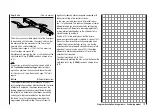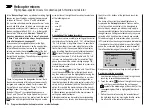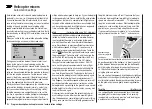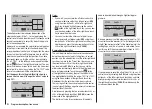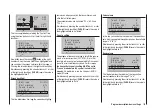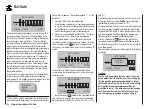
124
Program description: helicopter mixers / auto-rotation settings
Helicopter mixers
Auto-rotation settings
Auto-rotation allows full-size and model helicopters to
land safely in a crisis, i. e. if the power plant should fail.
It can also be used if the tail rotor should fail, in which
case cutting the motor and carrying out an auto-rotation
landing is the only possible way of avoiding a high-
speed uncontrollable rotation around the vertical axis,
invariably terminating in a catastrophic crash. And that is
the reason why switching INTO auto-rotation occurs with
zero delay.
When you switch to the auto-rotation phase the helicop-
ter mixers change as shown in this screen shot:
tail
ptch
thro
Autorot
gyro
0%
inp8
0%
0%
–90%
During an auto-rotation descent the main rotor is not
driven by the motor; it is kept spinning only by the
airflow through the rotor disc caused by the speed of the
descent. The rotational energy stored in the still spinning
rotor can be consumed to allow the machine to flare out,
but this can only be done once. For this reason “autos”
are only likely to be successful if the pilot has plenty of
experience in handling model helicopters, and has also
set up the appropriate functions with great care.
Once you have sufficient experience you should practise
auto-rotation landings at regular intervals, not only so
that you can demonstrate your all-round flying skill by
flying the manoeuvre in competitions, but also so that
you are in a position to land the helicopter undamaged
from a great height if the motor should fail. For this
purpose the program provides a range of adjustment fa-
cilities which are designed to help you fly your helicopter
in its unpowered state. Please note that the auto-rotation
setting takes the form of a complete fourth flight phase,
for which all the adjustment facilities are available which
can be varied separately for all flight phases, especially
trims, collective pitch curve settings etc.
ptch
(Collective pitch curve (Ch1
pitch))
In powered flight the maximum blade pitch angle is
limited by the motor power which is available; however,
in auto-rotation the angle is only limited by the point
at which the airflow over the main rotor blades breaks
away. Nevertheless, to provide sufficient upthrust even
when rotational speed is falling off, it is necessary to
set a greater maximum collective pitch value. Touch the
central
SET
button of the right-hand touch-key to select
the graph page of “Collective pitch”, and then move the
vertical line to Point 5 using the transmitter stick. Start
by setting a value which is about 10 to 20% higher
than your normal collective pitch maximum. Do NOT
set a
much
higher value compared with normal flight
initially, because collective pitch control will then differ
too greatly from the machine’s usual response after
you have thrown the switch. The danger is that you will
over-control the helicopter, and it may balloon up again
during the flare following the auto-rotation descent. If
this happens, the rotational speed of the main rotor will
quickly decline to the point where it collapses, and the
helicopter ends up crashing to the ground from a consid-
erable height. Later, after a few trial autos, you may wish
to adjust the value again.
Under certain circumstances the collective pitch mini-
mum setting
may
also differ from the normal flight set-
ting; this depends on your piloting style for normal flying.
In any case you must set a sufficiently generous collec-
tive pitch minimum value at Point 1 to ensure that your
model can be brought from forward flight at moderate
speed into a descent of around 60 ... 70° when collec-
tive pitch is reduced to minimum. Most helicopter pilots
already use such a setting for normal flying, and if this
applies to you, you can simply adopt the same value.
If you normally allow your model to “fall” at a shallower
angle, increase the value for “Point 1”, and vice versa.
Approach angle
under varying wind
conditions.
Approach angle
in moderate
wind
no wind
45°
60°
75°
in strong
wind
For auto-rotation the collective pitch stick itself may not
be positioned right at the bottom of its travel; typically it
will be between the hover position and the bottom end-
point, giving the pilot scope for correction if necessary,
i. e. the chance to adjust the model’s pitch inclination
using the pitch-axis control.
You can shorten the approach by pulling back slightly on
the pitch-axis stick and gently reducing collective pitch,
or alternatively extend the approach by pushing forward
on the pitch-axis stick and gently increasing collective
pitch.
Throttle
(throttle curve)
In a competition the pilot is expected to cut the motor
completely, but for practice purposes this is certainly
inconvenient, as after every practice “auto” landing you
would have to start the motor again.
Summary of Contents for mx-12 Hott
Page 1: ...Programming Manual 33116 mx 16 HoTT 3 en mx 16...
Page 35: ...35 For your notes...
Page 49: ...49 For your notes...
Page 55: ...55 For your notes...
Page 59: ...59 For your notes...
Page 63: ...63 For your notes...
Page 69: ...69 For your notes...
Page 91: ...91 For your notes...
Page 101: ...101 For your notes...
Page 123: ...123 For your notes...
Page 181: ...181 For your notes...
Page 193: ...193 For your notes...




